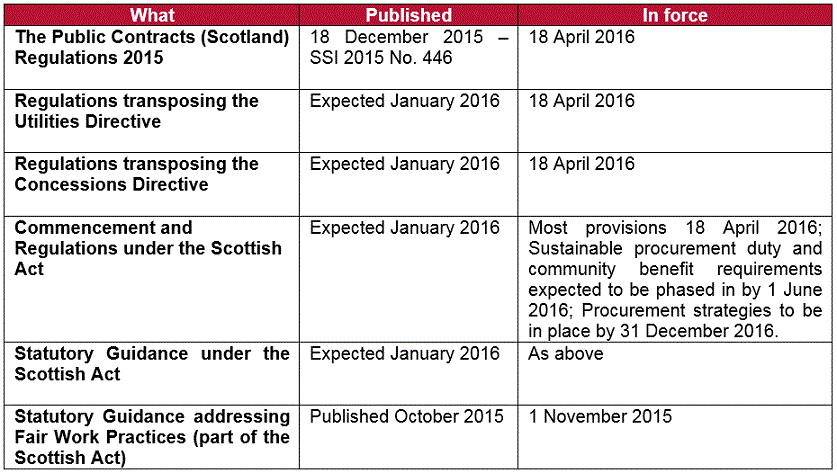15 January 2016
New rules on public procurement in Scotland will take effect in April 2016. Public bodies (“contracting authorities”) and those who tender for public contracts should be getting up to speed with the changes now.
What are the rules?
There are rules on public procurement that arise as a result of EU Directives. Three new EU directives were introduced in 2014 (1) – the public procurement directive, the utilities directive and the concessions directive. These must be implemented into Scots law by April 2016 – via Regulations. One set of regulations transposing the public procurement directive, The Public Contracts (Scotland) Regulations 2015 were laid before Parliament on 18 December 2015 and shall take effect on 18 April 2016. Regulations to transpose the two other directives are expected in January 2016.
South of the border, the Public Contracts Regulations 2015 have been in force since February 2015. Although broadly similar, The Public Contracts (Scotland) Regulations 2015 have some different provisions. That is because the EU Directive contained mandatory provisions to which all member states must adhere, but also gave member states discretion on how to implement certain provisions and the Scottish Government has taken a different approach to England and Wales in certain areas.
The Procurement Reform (Scotland) Act 2014 (‘the Scottish Act’) introduces a ‘second layer’ of procurement reform into Scots Law introducing, among others, rules on lower value contracts. Although on the statute books since June 2014, the substance of the Scottish Act is not yet in force. One element, mandatory Statutory Guidance addressing Fair Work Practices, was introduced last year. Regulations to bring most of the substance of the Scottish Act into force are also expected in January 2016, and will come into effect largely on 18 April 2016 along with the Regulations transposing the two other EU Directives. Further mandatory Statutory Guidance will also be introduced to describe what is required to comply with the Scottish Act. Contracting authorities must follow such Statutory Guidance.
So come April 2016, those undertaking public procurements in Scotland will need to comply with the new EU rules and the relevant provisions of the Scottish Act. This update focuses on The Public Contracts (Scotland) Regulations 2015 and the Scottish Act.
Timescales?

What’s new at a glance – The Public Contracts (Scotland) Regulations 2015?
Many of the provisions of The Public Contracts (Scotland) Regulations 2015 are similar to those found in the EU regime they are replacing. Part of the Scottish Government Economic Strategy centres around harnessing the public spend to deliver wider social, economic and environmental benefits as well as provide access to SMEs. These themes can been seen in some of the new provisions as well as expected procedural changes to supposedly make procurement easier and faster.
Procedural changes:
A number of procedural changes have been introduced including shorter, minimum time limits for procurement exercises, clarity on pre-market consultation, compulsory communication by electronic means (to be phased into Scotland by 2018), and the introduction of the European Single Procurement Document (“ESPD”).
The distinction between “Part A” and “Part B” services is removed and a “light touch” regime introduced to apply to a limited number of contract subjects such as some social services.
Fairer work practices and more sustainable procurement:
A failure to meet tax or social security obligations is now a mandatory ground for excluding businesses from bidding where properly established. Another mandatory ground for excluding a bidder is where the business has committed an act prohibited under the Blacklisting Regulations (2) or admitted doing so.
A new discretionary ground has been introduced for excluding a business that is in breach of social, environmental and employment law obligations. Further, contracts once awarded should include clauses ensuring contractors comply with their obligations in these areas.
Opting for the lowest price or cost is now expressly prohibited and tenders must be awarded on the basis of the most economically advantageous tender.
Reserving certain contracts for supported businesses remains, however the threshold percentage of disabled employees for a business to be classified as ‘supported’ is reduced from 50% to 30%.
Greater access to SMEs / supported supply chain:
There is also positive news for SMEs. The minimum level of turnover which a contracting authority can require a business to have in order to bid will be no more than 2 times the value of the contract (apart from in exceptional circumstances). The introduction of the ESPD should also reduce the administrative burden placed on smaller businesses in tendering for work, albeit this has been recognised to date with the standard pre-qualification questionnaire in Scotland.
The contracting authority must consider breaking its requirement into smaller lots but is not required to do so. The Scottish Government has not gone as far as it could have in terms of supporting the supply chain (although there is more within the Scottish Act – see below) but instead has opted for what it considers a proportionate response: a contracting authority may ask a bidder about subcontractor involvement (but need not) and a contracting authority may make payments direct to a subcontractor where the contract allows for it but this is not required.
Interestingly, The Public Contracts Regulations 2015 contain additional miscellaneous provisions not found in the Scottish Regulations, requiring contracting authorities to ensure every public contract they are aware of contains provisions to require payment to the contractor and contractor’s supply chain to be made within 30 days. Of course, the Scottish Government has been seeking to promote this policy for some years (see SPPN 8/2009) and a different approach has been taken via provisions in the Scottish Act (see further below).
What is new at a glance – The Scottish Act?
- Introduces the concept of ‘regulated procurements’ which are public contracts with an estimated value in excess of £2m for works contracts or £50k for other types of contract (with certain exceptions).
- In carrying out any regulated procurement, the contracting authority must comply with the so-called sustainable procurement duty which includes:
(i) How the procurement can improve economic, social and environmental wellbeing of the area;
(ii) Involve SMEs, third sector bodies and supported business; and
(iii) Promote innovation. Statutory guidance on this topic is expected in January 2016 from the Scottish Government.
- Contracting authorities with a significant procurement expenditure (regulated procurements equal to or greater than £5m) must prepare a procurement strategy and annual report. The procurement strategy must include a statement on the contracting authority’s general policy on, among others, the use of community benefits and payment of a living wage. Statutory guidance on the payment of a living wage has already been published. Part of the procurement strategy must set out how the contracting authority intends to ensure, so far as reasonably practicable, payments to the contractor and down the supply chain are made within 30 days of invoice. It will be interesting to see what measures are put in place and how effective they are to counter the perennial problem of slow payments in the construction industry.
- The inclusion of community benefit requirements must be considered for any regulated procurement of £4m or more.
Where can I find out more?
- BTO will be hosting a seminar to go through the changes in more detail later in the Spring. If you would be interested in attending a seminar on this topic, please contact us.
- If you would like to subscribe to BTO's Construction and Engineering team updates, please contact us.
If you require further information about this update, please do not hesitate to contact:
Fraser Hopkins, Partner, E: fho@bto.co.uk / T: 0141 225 4858
(1) 2014/24/EU; 2014/25/EU; and 2014/23/EU
(2) Employment Relations Act 1999 (Blacklists) Regulations 2010


